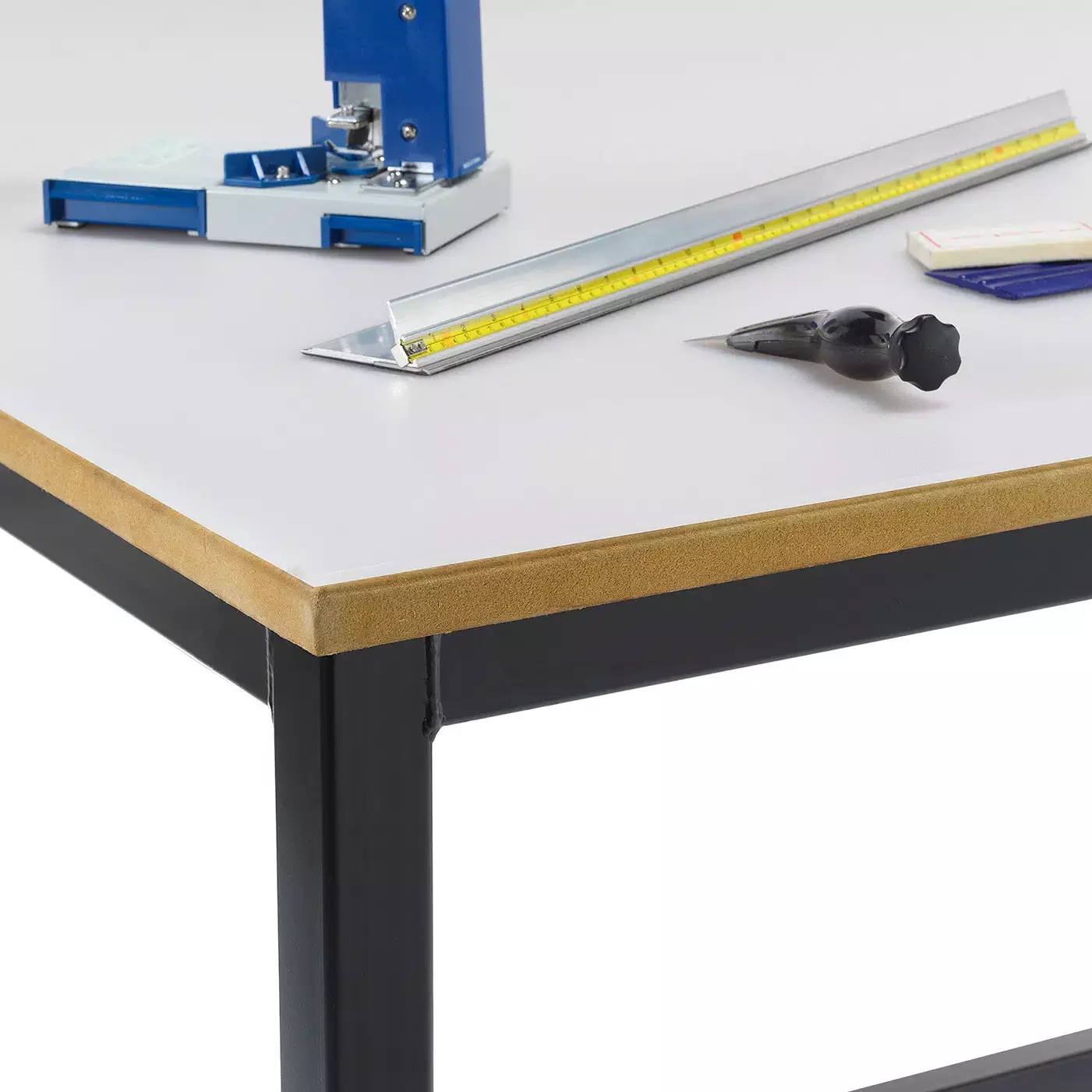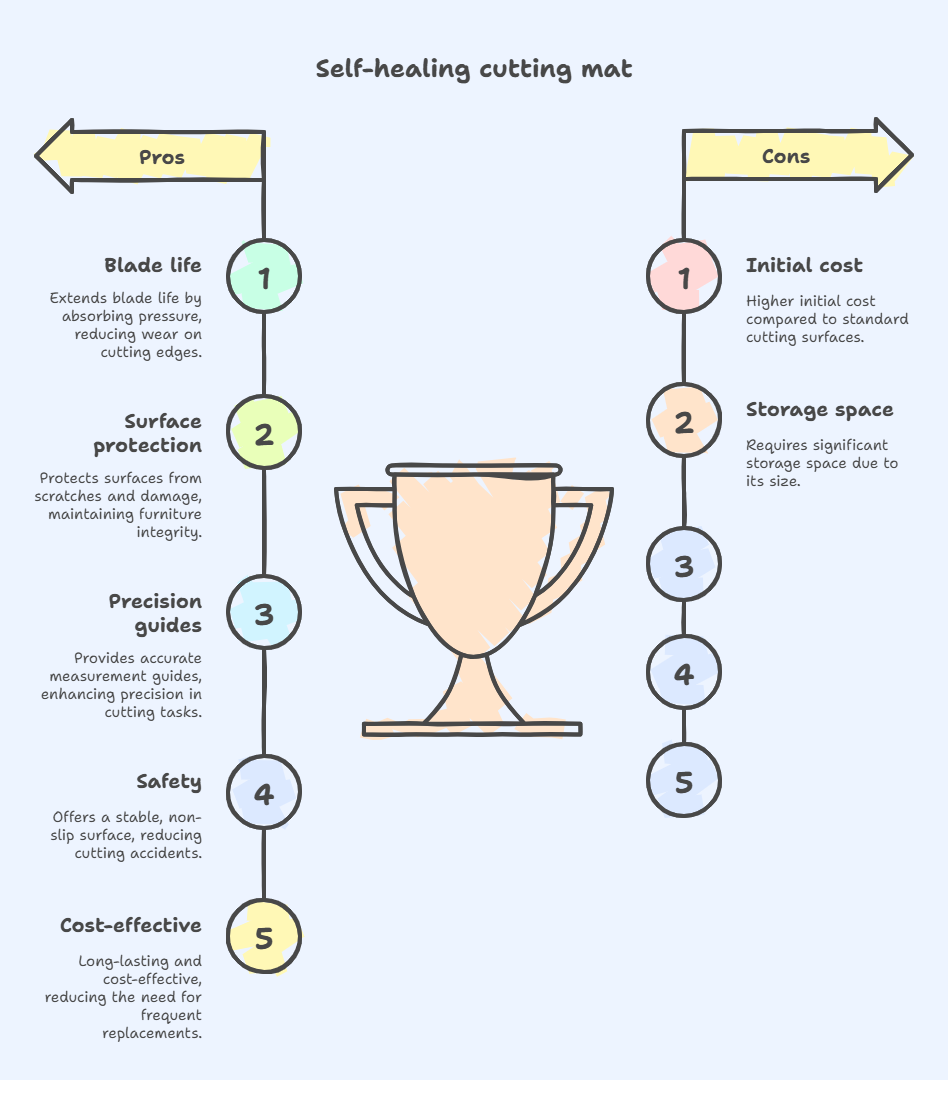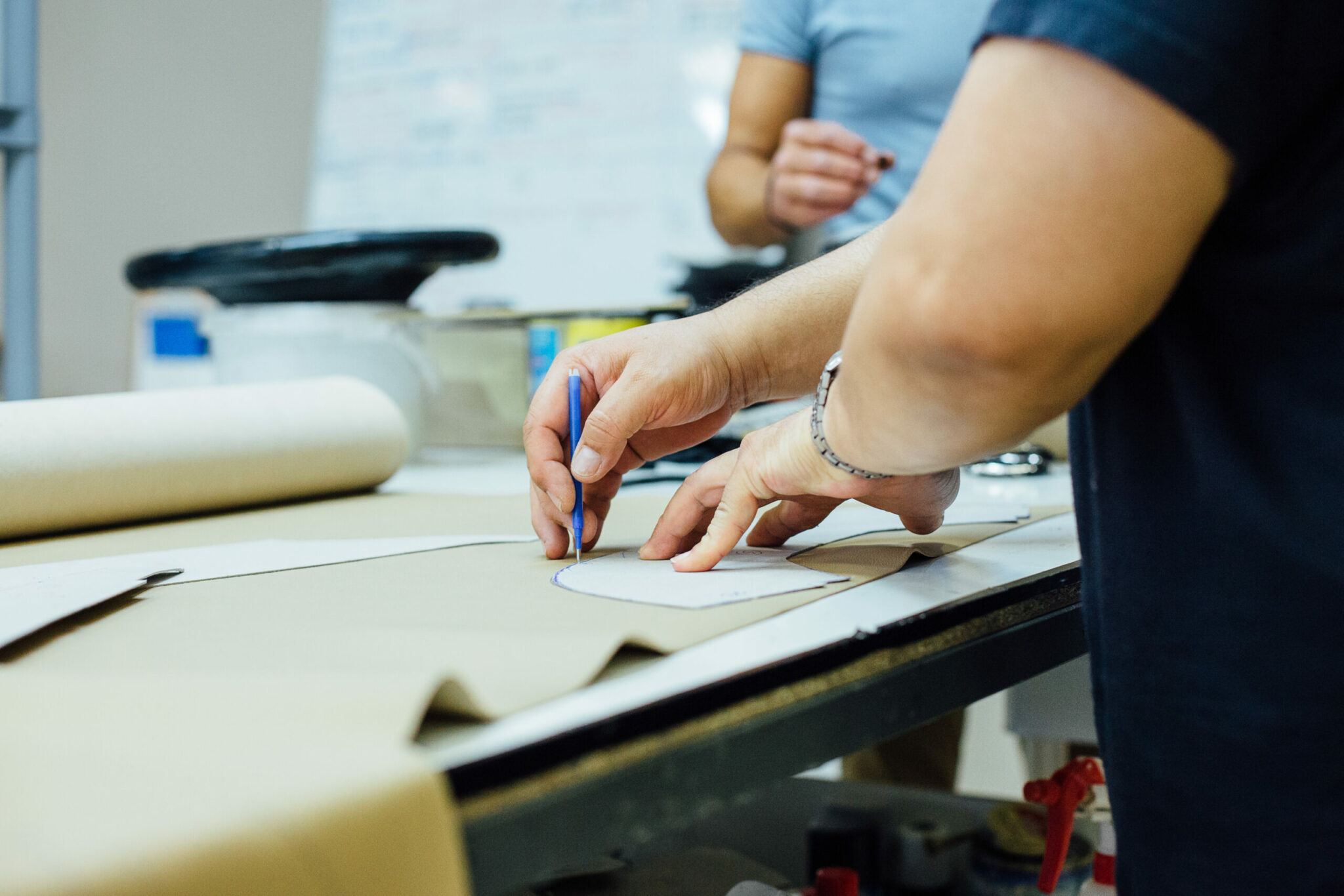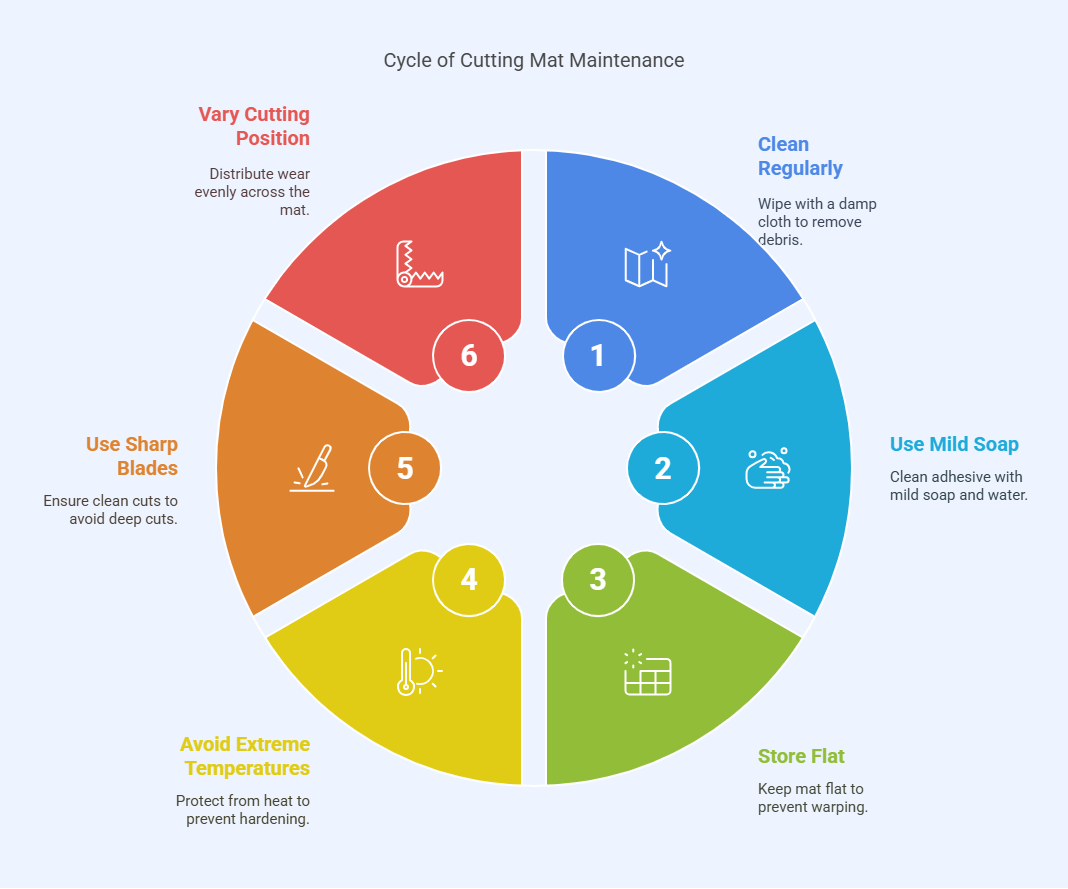What is a Self-Healing Cutting Mat and Why Do You Need One?

Self-Healing Cutting Mat: Why You Need One for Precision and Durability
A self-healing cutting mat is an essential tool for anyone working with precision cutting, whether for crafting, sewing, model-making or professional design. Unlike standard cutting boards, these mats are made from flexible, durable materials that allow the surface to close up after each cut, preventing deep grooves that can affect accuracy. They provide a stable, non-slip workspace while extending the lifespan of cutting blades by reducing friction. For hobbyists and professionals alike, a self-healing cutting mat protects work surfaces, enhances precision and ensures a smoother workflow. Investing in the right mat can improve efficiency and maintain tool sharpness over time.
What Is a Self-Healing Cutting Mat?
A self-healing cutting mat is a specialised work surface designed to withstand repeated cutting while maintaining a smooth and even texture. Unlike standard cutting boards that develop permanent grooves, these mats are made from multiple layers of flexible material that close up after each cut, preventing deep incisions. This feature not only keeps the mat usable for longer but also ensures a consistently smooth cutting surface for precise work.
How Does the Self-Healing Surface Work?
Self-healing technology relies on the mat’s layered structure, typically made from PVC (polyvinyl chloride) or similar resilient materials. When a blade presses into the mat, the surface separates rather than slicing through completely. Once the blade is removed, the flexible material returns to its original position, appearing as though the cut has disappeared. While the mat doesn’t technically “heal” like living tissue, the effect extends its usability and prevents the formation of deep grooves that can misalign future cuts.
What Materials Are Used?
Most high-quality self-healing cutting mats are made from several layers of PVC, with a soft top layer to absorb cuts and a firmer core for stability. Some premium mats use multiple composite layers to enhance durability and flexibility. These mats are designed to resist warping and cracking, even after prolonged use. They are also available in single- and double-sided versions, with grid lines printed on the surface to aid precision cutting in crafting, sewing and model-making projects.
Explore More: Rhino Heavy Duty Self-Healing Cutting Mat
How Does a Self-Healing Cutting Mat Work?
A self-healing cutting mat is designed to provide a durable and reliable surface that maintains its integrity even after repeated use. Its unique construction allows it to withstand continuous cutting without developing deep grooves, making it an essential tool for precision work.
The Layered Structure of a Self-Healing Cutting Mat
Most self-healing cutting mats are made up of multiple layers of PVC or similar flexible materials. The topmost layer is designed to absorb cuts, while the inner layers provide stability and prevent the blade from cutting through completely. This layered structure ensures the mat remains smooth over time, preventing ridges that could misalign cuts or damage materials.
How the Surface Closes Up After Cuts
When a blade presses into the mat, it separates the material rather than slicing through it. The flexible nature of the top layer allows it to “self-heal” by returning to its original position once the blade is lifted. While the cut doesn’t disappear entirely, the material seals itself enough to keep the surface smooth, reducing blade wear and ensuring consistent cutting accuracy.
Benefits of Using a Self-Healing Cutting Mat
A self-healing cutting mat is more than just a protective surface—it enhances precision, improves safety and extends the life of cutting tools. Whether you are a professional designer, a crafter or someone who frequently works with sharp blades, investing in a high-quality cutting mat offers multiple advantages.
Extends the Life of Cutting Blades
Using a self-healing cutting mat significantly reduces wear on blades compared to hard surfaces like wood, glass or metal rulers. When cutting on a hard surface, the blade’s edge dulls quickly due to repeated impact. In contrast, a self-healing mat absorbs the pressure, allowing the blade to glide smoothly without excessive friction. This helps maintain sharpness for longer, reducing the need for frequent replacements and ensuring cleaner, more precise cuts.
Protects Work Surfaces
Cutting directly on a desk or tabletop can cause permanent damage, including deep scratches and uneven surfaces. A self-healing cutting mat acts as a protective layer, absorbing the force of the blade and preventing unwanted marks on furniture. This is especially beneficial for home crafters, students and professionals working in shared or rented spaces where maintaining surfaces is crucial.
Provides Measurement Guides for Precision
Many self-healing cutting mats come with printed gridlines, measurement markings, and angle guides. These features assist with accurate cutting, reducing the need for rulers and additional tools. Some mats include both metric and imperial measurements, making them useful for crafters, designers and engineers who need precise dimensions for their projects. Crafters working with fabric, paper or vinyl find these guides particularly helpful for cutting straight lines and creating uniform shapes.
Extends the Life of Work Surfaces and Cutting Blades
Workbenches, tables and other surfaces can suffer from repeated knife cuts, leading to costly damage over time. A self-healing cutting mat acts as a protective barrier, preventing deep scratches and gouges. Additionally, by reducing the impact on cutting blades, it helps users avoid constant replacements, ultimately saving time and money on new tools.
Enhances Safety and Reduces Slips
A self-healing cutting mat provides a stable and non-slip surface, reducing the risk of accidental slips while cutting. Many mats also have a slightly textured surface that helps hold materials in place, minimising movement during cutting tasks. This is particularly important for activities requiring high precision, such as quilting, sewing, or paper crafts, where even a small slip can lead to errors or injuries.
Cost-Effective and Long-Lasting
Investing in a self-healing cutting mat is cost-effective in the long run. The self-repairing surface allows users to make thousands of cuts before showing signs of wear. Since the mat retains its smoothness, it eliminates the need for frequent replacements. Double-sided mats also provide extended usage, as they can be flipped over once one side begins to wear out.
For anyone working with precision cutting—whether in arts, crafts, model making, or professional design—a self-healing cutting mat is an essential tool that improves efficiency, extends the life of cutting blades, and protects work surfaces from damage.
Read More: How Do You Tell if a Cutting Board Self-Heals?
Choosing the Right Self-Healing Cutting Mat
Selecting the right self-healing cutting mat depends on several factors, including size, thickness, material quality, and additional features. Choosing the best mat for your needs ensures precision, prolongs the life of your cutting tools, and protects your workspace. Below are key considerations to help you make an informed decision.
Size Considerations
Self-healing cutting mats come in various sizes, commonly including A4, A3, A2, and A1, as well as larger custom options. The right size depends on your workspace and project requirements:
- A4 (210 x 297mm) – Best for small-scale crafts like card making, small fabric cuts, and scrapbooking.
- A3 (297 x 420mm) – A medium-sized option, ideal for quilting, sewing patterns, and moderate cutting projects.
- A2 (420 x 594mm) and larger – Best suited for professional use, such as architectural modelling, dressmaking, or large-scale artwork.
For flexibility, consider multiple sizes—smaller mats for portable tasks and larger ones for dedicated workspaces.
Thickness and Durability
The thickness of a self-healing cutting mat directly impacts its durability.
- Standard (3mm) – A cost-effective choice for light cutting tasks, such as paper crafts or vinyl work.
- Heavy-duty (5mm or thicker) – Provides a sturdier surface for more frequent cutting, ideal for fabric cutting, quilting, and industrial use.
Thicker mats last longer and protect surfaces better, but they can be heavier and less portable. If you frequently use rotary cutters or heavy-duty craft knives, investing in a thicker mat will prevent damage to your workspace and blades.
Gridlines and Markings for Precision Cutting
Many self-healing cutting mats feature printed measurement guides, which are essential for precise cutting. When choosing a mat, consider:
- Metric vs. Imperial Measurements – Some mats display only centimetres, inches, or both. Choose based on your preferred measurement system.
- Pre-Marked Gridlines – Useful for aligning materials and ensuring straight, even cuts.
- Angle Guides – Many mats have 30°, 45°, and 60° angle guides, which help with cutting fabric, quilting, or design projects.
- Self-Repairing Properties – High-quality mats will “heal” quickly and not show deep grooves after cutting, ensuring longevity and a smooth surface for future projects.
Additional Features to Consider
- Self-healing quality – Look for mats with multiple PVC layers or other self-repairing materials for enhanced durability.
- Double-sided usage – Some self-healing cutting mats have measurements printed on both sides, effectively doubling their lifespan.
- Non-slip surface – A textured backing prevents the mat from shifting on smooth work surfaces, reducing the risk of errors.
- Non-glare surface – A matte finish minimises reflections, reducing eye strain during extended use.
- Heat resistance – Some mats can handle heat from crafting tools like glue guns without warping.
Investing in the Right Mat for Long-Term Use
A high-quality self-healing cutting mat is a long-term investment that can save money by preserving tools and protecting work surfaces. When choosing a mat, consider the type of work you do, how often you’ll use it, and what features will improve accuracy and efficiency. Whether you’re a professional designer, an artist, or a DIY enthusiast, selecting the right cutting mat can make a significant difference in both precision and longevity.
Read More: Everything You Need to Know About Self-Healing Cutting Mats
How to Maintain a Self-Healing Cutting Mat for Longevity
A self-healing cutting mat is a long-lasting tool, but proper care is essential to maintain its self-repairing properties and extend its lifespan. By following a few simple maintenance steps, you can keep your cutting mat in optimal condition for years to come.
Proper Cleaning and Maintenance
Regular cleaning prevents dirt, dust, and small particles from getting embedded in the mat’s surface. To keep your mat in good condition:
- Wipe the surface with a damp cloth after each use to remove debris.
- Use mild soap and lukewarm water to clean any adhesive or residue.
- Avoid using harsh chemicals or solvents, as they can break down the self-healing properties of the mat.
Similarly, maintaining your overall workstation through regular workbench maintenance and care can help to ensure your mat and workbench surfaces remain stable, level, and safe for ongoing use. A consistent cleaning routine for tools and benches minimises contamination, supports long-term performance, and maintains industrial cutting mat care standards.
Store and Handle with Care
Improper storage can lead to warping, making the mat unusable. To prevent this:
- Store the mat flat whenever possible. Hanging it or rolling it tightly for long periods can cause bending.
- Keep the mat away from extreme temperatures, as excessive heat can warp or harden the surface, reducing its ability to self-heal.
- Avoid placing heavy objects on the mat when not in use to prevent distortion.
Prevent Deep Cuts and Dents
Although a self-healing cutting mat repairs itself, deep cuts can become permanent over time. To avoid damaging the mat:
- Use a sharp blade—dull blades require more pressure and can gouge the surface.
- Vary your cutting position to distribute wear evenly across the mat.
- Avoid using serrated knives or tools with aggressive cutting edges that could tear the mat instead of slicing cleanly through materials.
By following these care tips, you can keep your self-healing cutting mat in great shape, ensuring it remains an effective tool for precise cutting while prolonging the lifespan of your cutting blades and protecting your work surface.
Who Needs a Self-Healing Cutting Mat?
A self-healing cutting mat is an essential tool for anyone who works with precision cutting. Whether you are a professional or a hobbyist, the right cutting mat can improve accuracy, protect surfaces, and extend the life of your cutting tools.
Graphic Designers and Architects
Professionals in design and architecture often need to cut paper, foam boards, or card stock with precision. A self-healing cutting mat provides a stable, non-slip surface for trimming layouts, mock-ups, and blueprints, ensuring clean and accurate cuts.
Crafters and Hobbyists
From scrapbooking and card making to DIY home projects, crafters rely on cutting mats to protect their workspaces and achieve precise cuts. The built-in gridlines help with measuring and aligning materials, reducing errors.
Sewing and Quilting Enthusiasts
For those working with fabric, a self-healing cutting mat is crucial when using rotary cutters. It prevents fraying and shifting, allowing for smooth, clean cuts essential in quilting and sewing projects.
Model Makers and Engineers
Model builders, engineers, and students working on scale models or prototypes benefit from a cutting mat’s precision gridlines and self-repairing surface. The mat ensures consistency and accuracy when cutting intricate parts.
Anyone working with sharp tools and detailed cutting will find a self-healing cutting mat a valuable investment for improving efficiency and maintaining their workspace.
Final Thoughts
A self-healing cutting mat is an essential tool for professionals and hobbyists who work with cutting tools. It protects work surfaces, extends the life of blades, and enhances accuracy for tasks like sewing, quilting, model-making, and crafting.
With features like gridlines, angle guides, and non-slip surfaces, a high-quality cutting mat makes precision work easier and safer. Investing in a durable, self-repairing cutting mat not only ensures cleaner cuts but also helps save money by reducing blade wear and preventing damage to work surfaces. Whether for professional use or DIY projects, a self-healing cutting mat is a smart addition to any workspace.




